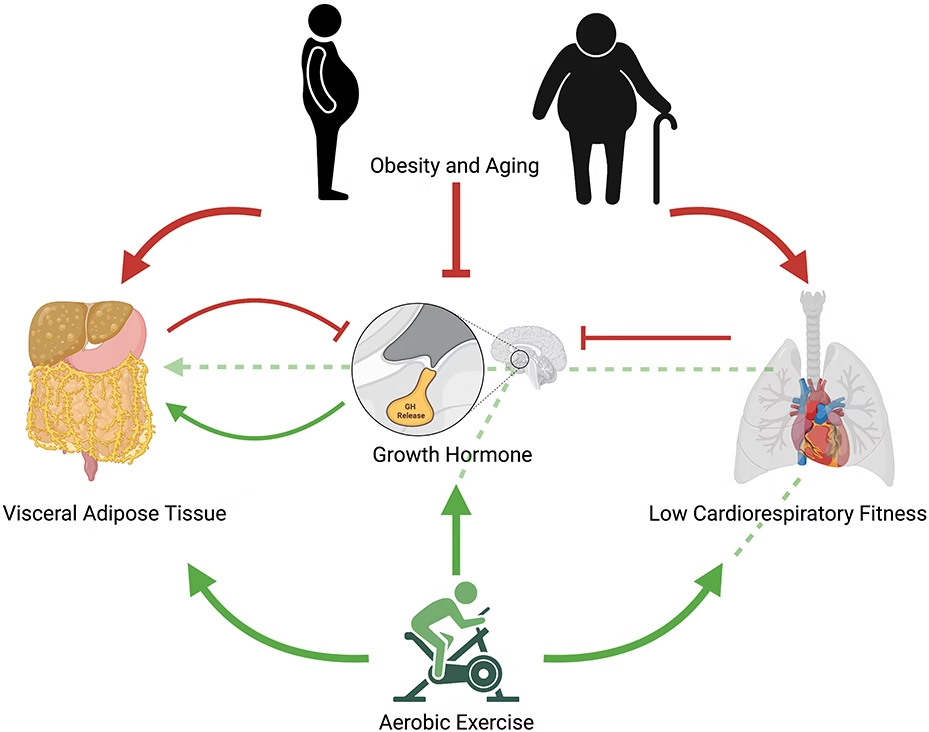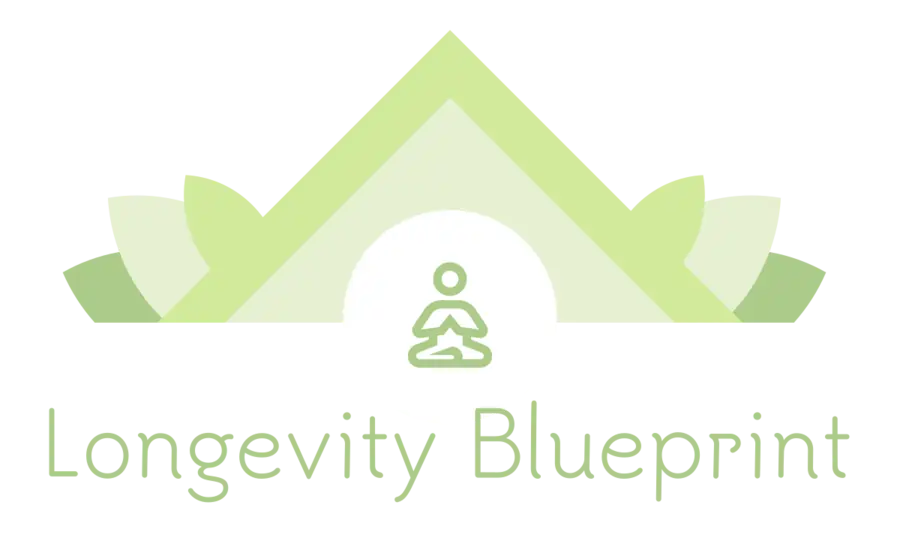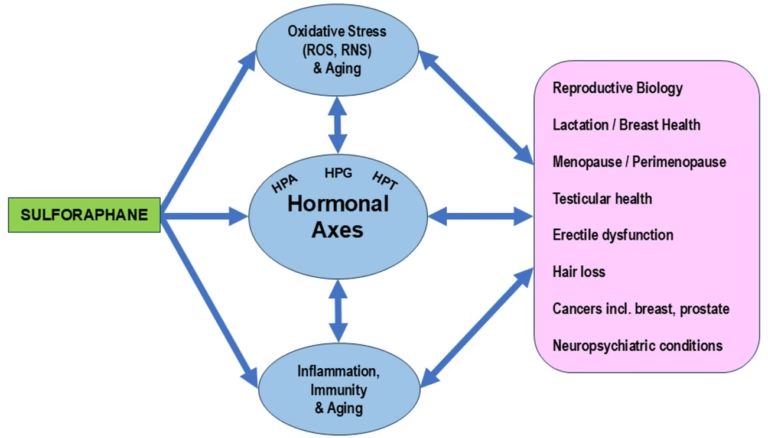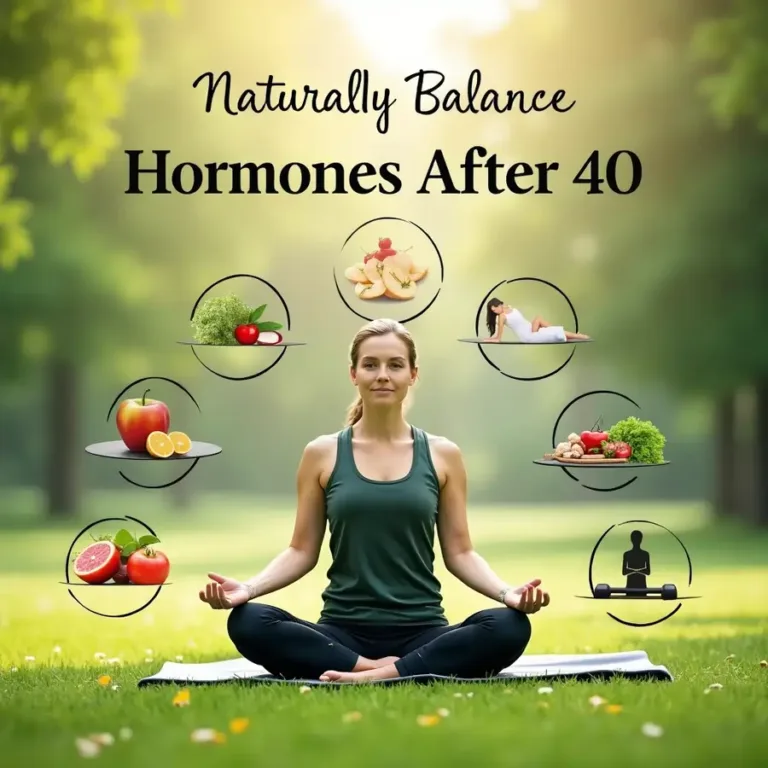7 Science-Backed Ways to Increase Growth Hormone Naturally

Would you believe that a simple lifestyle change could increase your growth hormone levels by up to 1250%? Science has found amazing things about how fasting affects HGH production, and that’s just the start.
Human growth hormone (HGH) has a significant role in our body’s growth and fat metabolism, especially during childhood and adolescence. The pituitary gland releases this vital hormone every 3 to 5 hours, and production peaks during deep sleep. But excess belly fat and poor sleep can suppress our natural HGH levels by a lot.
Research has found several science-backed ways to boost HGH production naturally. Studies show that high-intensity exercise increases HGH dramatically, and even small doses of specific amino acids can increase levels by up to 78%. Let’s explore these proven strategies that don’t need synthetic supplements or medical intervention.
High-Intensity Exercise: The Most Powerful HGH Stimulator

Image Source: Frontiers
“HIIE is a brief and individualized exercise protocol that may be used as a physiological provocation test for GH secretion.”
— Dr. Alon Eliakim, Professor of Pediatrics, Head of the Pediatric Endocrinology Unit at Meir Medical Center
Nothing beats high-intensity exercise to boost your body’s natural growth hormone production. Research shows intense physical activity can increase growth hormone levels by up to 450% in the 24 hours after your workout [1]. This makes exercise the most powerful non-pharmacological way to release HGH.
How Exercise Triggers Growth Hormone Release
Your body releases growth hormone through multiple pathways during exercise. The body uses more oxygen during intense activity and this pushes it into an anaerobic state [1]. Studies show that once you hit your lactate threshold (where lactic acid starts building up in your bloodstream), your body produces much more HGH [2].
The science behind this involves neural input, catecholamine stimulation, and changes in acid-base balance [2]. Research points to afferent stimulation, nitric oxide, and lactate as the main drivers of this process [2]. Growth hormone starts rising 10-15 minutes after you begin exercising. It peaks during or right after the workout and stays higher than normal for about 2 hours afterward [3].
Optimal Exercise Types for Maximum HGH Production
Each type of exercise affects hormones differently. High-intensity interval training (HIIT) creates the biggest increases in growth hormone. Research shows a linear relationship between exercise intensity and the amount of HGH released, whatever your age or gender [4].
Studies show you’ll get the best results by exercising above your lactate threshold for at least 10 minutes [2][5]. On top of that, resistance training with the right load and frequency triggers a lot of growth hormone release [2]. Compound movements that use multiple muscle groups at once—like deadlifts, bent-over rows, pullups, and hang cleans—create the strongest hormonal response [6].
Intensity plays a vital role. High-intensity protocols create much higher and longer-lasting hormone levels than moderate-intensity continuous exercise [5]. This happens because higher intensities use more muscle fibers and create more metabolic stress, which are powerful signals for hormone production.
Sample HIIT Workout to Boost Growth Hormone
Here’s a HIIT workout designed to maximize growth hormone release, based on research:
- Warm-up: 5 minutes light cycling or jogging
- Main workout: Do 4 sets of 30-second all-out sprints on a bike or running, followed by 4 minutes of active recovery at low intensity [5]
- Alternative protocol: 10 intervals of 15-second high-intensity pedaling with 45-second recovery periods [7]
- Cool-down: 5 minutes of light movement
This workout takes about 25-30 minutes, making it time-efficient while delivering powerful hormonal benefits. This type of workout increases both pulsatile and total 24-hour growth hormone secretion [5].
How Often to Exercise for Sustained HGH Benefits
Consistency matters more than frequency to get ongoing HGH benefits. You’ll get the best hormone stimulation with 2-3 HIIT sessions per week without overtraining [8]. Adding 2-3 resistance training sessions that focus on compound movements helps boost these hormonal benefits [8].
Multiple aerobic exercise sessions within 24 hours lead to higher overall GH concentrations [4]. The second and third exercise sessions might actually trigger 2.5-3.5 times more hormone release than your first session [3].
Research with young women showed that regular aerobic training above the lactate threshold doubled their 24-hour growth hormone release [4]. A consistent exercise program above threshold intensity helps maintain these hormonal benefits.
Exercise offers a powerful, natural alternative to synthetic supplements for growth hormone production. You can optimize your body’s hormonal environment to support muscle growth, fat loss, and overall vitality by using high-intensity training strategically.
Resources:
- American College of Sports Medicine: www.acsm.org
- National Strength and Conditioning Association: www.nsca.com
- Journal of Applied Physiology: www.physiology.org/journal/jappl
Intermittent Fasting: Strategic Eating for HGH Optimization
Fasting stands out as one of nature’s most powerful ways to boost growth hormone production. Studies show a remarkable 5-fold increase in HGH levels during a 24-hour water-only fast [9]. Women see even better results, with levels jumping up to 14 times higher [9]. These dramatic changes make intermittent fasting an attractive option to boost growth hormone naturally.
The Science Behind Fasting and Growth Hormone
Our evolutionary biology explains the connection between fasting and growth hormone. The body switches on several protective mechanisms when food isn’t available. HGH secretion increases substantially because fasting lowers insulin levels, which affects HGH production directly [10].
Studies show that fasting affects HGH regardless of weight loss [11]. Many people believe you need to lose weight to see hormonal benefits. Research proves that HGH levels rise substantially even without dropping pounds [9]. This happens through several pathways:
- Lower insulin resistance leads to better growth hormone signaling [10]
- Growth hormone helps break down triglycerides into free fatty acids during fasting [9]
- The body switches from using glucose to ketones for energy during fasting [9]
People with lower HGH levels see the biggest relative increases during fasting. Some studies report up to 720% increases in females who start with low HGH levels [7]. This suggests that people who need the hormonal boost most benefit the most from fasting.
Different Fasting Protocols and Their Effects on HGH
You can choose from several fasting approaches to increase growth hormone:
16:8 Method: This popular approach lets you eat during an 8-hour window while fasting for 16 hours daily [3]. Research on this method is limited compared to longer fasts. The 16-hour period creates good conditions for growth hormone release by keeping insulin levels low [12].
24-Hour Fast: A full day of water-only fasting shows the most documented HGH increases—the 5-14 fold rises mentioned earlier [9]. Research confirms this duration triggers significant metabolic changes without being too challenging [7].
5-Day Fast: Longer fasts show more dramatic effects. One study found increased discrete GH pulse frequency (5.8 vs. 9.9 pulses/24h) and 24-hour integrated GH concentration (2.82 vs. 8.75 μg·min/ml) [13].
Weekly Fasting: A 26-week study looked at people who fasted for 24 hours once per week. Results showed lasting improvements in insulin sensitivity, especially in those with lower baseline HGH [11]. This suggests regular fasting might create long-term hormonal benefits.
Your lifestyle and health status should guide your choice between protocols. Shorter fasting periods still help if you practice them regularly.
How to Start Intermittent Fasting Safely
The powerful effects of fasting on hormones require a careful approach:
Start gradually: Begin with a 12-hour overnight fast. Extend it to 14, 16, or more hours as your body adapts [3].
Stay hydrated: Drink plenty of water throughout your fast, even though you’re not eating [3].
Listen to your body: Break your fast if you feel severe discomfort, headaches, or weakness [3]. Everyone responds differently. Pushing too hard can backfire.
Think over individual factors: Women might need a more careful approach. Studies suggest fasting affects female hormones differently [3]. Medical conditions also require special consideration.
Focus on nutrition: Choose nutrient-dense foods during eating windows [14]. Good food choices matter—fasting doesn’t mean you can eat processed foods freely.
Pregnant or breastfeeding women, people with eating disorders, those under 18, or individuals with certain medical conditions like diabetes or hypoglycemia should not try intermittent fasting without medical supervision [14].
Resources:
- Frontiers in Endocrinology: www.frontiersin.org/journals/endocrinology
- The Journal of Clinical Endocrinology & Metabolism: academic.oup.com/jcem
- International Journal of Obesity: www.nature.com/ijo
Quality Sleep: Your Nightly HGH Boost
Your nightly rest might be the most underrated growth hormone booster you have. Exercise and fasting create temporary spikes in HGH, but sleep gives you a predictable and powerful surge every night. Research shows that 70-80% of your daily growth hormone releases during deep sleep [1]. Quality rest is essential to optimize your natural HGH levels.
The Growth Hormone Sleep Cycle
Growth hormone releases in a pattern that matches your sleep perfectly. The biggest HGH surge happens during your first episode of slow-wave sleep (SWS), usually within an hour after you fall asleep [8]. This connection between deep sleep and growth hormone is so reliable that scientists use it as a biological marker.
Your body goes through sleep stages four to five times during a normal night [8]. The main HGH release occurs in the early cycles, particularly during stage 3 sleep (deep sleep) [15]. This surge can last between 1.5 to 3.5 hours and reach peak levels of 13-72 mμg/ml [15].
The timing of this release depends on when you sleep, not just the clock. Studies show that delayed sleep leads to delayed peak HGH secretion [15]. Your body produces another significant pulse of growth hormone when you wake up for 2-3 hours and go back to sleep [15].
Creating the Ideal Sleep Environment for HGH Production
Here are some proven strategies to boost your natural growth hormone production through better sleep:
- Avoid blue light exposure before bed since it disrupts your circadian rhythm and delays deep sleep [2]
- Maintain a cool bedroom temperature to help you reach deeper sleep stages [2]
- Eliminate caffeine after midday because it stays in your system up to 12 hours [2]
- Create a consistent sleep schedule to support your body’s natural HGH release timing [8]
Research confirms these environmental changes improve more than just how well you sleep – they increase your time in slow-wave sleep, which leads to more HGH secretion [6].
Sleep Duration vs. Quality for Optimal Growth Hormone Release
Sleep duration alone doesn’t guarantee optimal HGH production. The quality and structure of your sleep matter more. Adults need 7-9 hours of uninterrupted sleep [2], but research shows that the amount of deep sleep during these hours is what really counts for HGH release.
Sleep deprivation makes your body’s normal nighttime GH surge disappear completely [16]. Long-term partial sleep restriction causes your body to adapt by developing two GH pulses – one before sleep and one after falling asleep [17]. In spite of that, neither pattern matches what you get with good quality sleep.
Six hours of uninterrupted, deep sleep are nowhere near as effective as six hours of broken sleep with frequent wake-ups. Good sleep quality should be your priority over just spending more time in bed if you want to increase growth hormone naturally.
Tracking Your Sleep to Maximize HGH Benefits
Sleep tracking is a great way to get insights when you want to optimize your HGH. While polysomnography (PSG) remains the best way to measure sleep [18], consumer sleep trackers can help you learn about your sleep patterns.
Choose devices or apps that measure sleep stages, especially deep sleep duration. These tools aren’t perfect but can help you spot patterns and see if your sleep improvements work. Many also give sleep quality scores that match up well with how you feel about your sleep.
Better deep sleep shows in how you feel the next day. More energy, faster workout recovery, and sharper thinking are signs that your nighttime HGH production is working well.
Resources:
- National Sleep Foundation: www.sleepfoundation.org
- American Academy of Sleep Medicine: www.aasm.org
- Sleep Research Society: www.sleepresearchsociety.org
Strategic Nutrition: Foods That Boost Growth Hormone

Image Source: Nature
Your food choices can make or break your body’s HGH production levels. Growth hormone reacts more to what you eat compared to other hormones. Smart nutrition choices are the life-blood of natural HGH improvement.
Amino Acids That Stimulate HGH Production
Some amino acids powerfully trigger growth hormone release. Glutamine leads the pack – studies show even small 2g doses can boost HGH levels up to 78% [19]. Arginine also shows substantial results by increasing HGH almost 60% with higher doses of 15-20g daily [5].
Research backs these amino acids for HGH benefits:
- Ornithine: Boosts growth hormone 5-fold in just 45 minutes [20]
- GABA: Lifts HGH levels up to 400% at rest and 200% after exercise [2]
- Lysine: Works best combined with arginine [2]
- Tryptophan: Shows best results with breakfast and sunlight exposure [5]
The Impact of Protein Timing on Growth Hormone
Your protein timing matters more than you might think. Taking protein right before exercise can lower your serum growth hormone levels [4]. A mix of 25g whey and caseinate proteins 30 minutes before strength training reduced GH during workouts [4]. However, protein after exercise helps muscle recovery and protein synthesis [21].
Research suggests these tips to maximize growth hormone benefits:
- Take protein right after resistance training [22]
- Leave 2 hours between protein intake and sleep [5]
- Choose quality protein sources (1.2g/kg/day) with resistance training [22]
Foods to Avoid That Suppress HGH
Some foods block growth hormone production through different ways. These HGH suppressors include:
- Sugar and refined carbs: They cause big drops in growth hormone values [23]. Insulin spikes trigger somatostatin release, which blocks HGH [12].
- Alcohol: Ruins sleep quality when HGH peaks and adds empty calories that increase body fat [12].
- High-fat foods: These cause problems especially late at night [12].
- Acidic foods: They can disrupt your sleep if eaten near bedtime [12].
- Caffeine: Puts your body in a breakdown rather than building state [12].
Meal Timing Strategies for Optimal Hormone Balance
Your meal timing affects growth hormone secretion. Insulin blocks HGH production, so spacing your meals becomes vital:
- Keep food and bedtime at least two hours apart to protect nighttime HGH production [5].
- Your body releases most HGH at night when insulin levels drop [24].
- Late-night eating throws off blood sugar balance and fat burning [25].
- Early-day eating helps your metabolic health [25].
- Try intermittent fasting with 16+ hour windows to optimize HGH [5].
Supplements That Support Natural HGH Production
Beyond food, specific supplements can boost your natural growth hormone levels:
- Melatonin: Better sleep leads to more natural HGH production [5].
- L-arginine and L-lysine combination: This pair works better than either one alone [20].
- Creatine: Both sprinters and distance runners showed higher HGH levels after 6 weeks [2].
- Glutamine: This amino acid reliably increases HGH [19].
- Essential amino acid blends: Healthy fasted volunteers showed an 8-fold HGH increase from baseline [19].
Your nutrition choices can optimize growth hormone production if you time your meals right and pick the right foods. Create an environment where your hormones thrive by choosing HGH-friendly foods and avoiding things that suppress it.
Resources:
- Journal of Clinical Endocrinology & Metabolism: academic.oup.com/jcem
- International Society of Sports Nutrition: www.jissn.com
- American Journal of Clinical Nutrition: academic.oup.com/ajcn
Stress Reduction: Protecting Your Growth Hormone Levels
Chronic stress takes a toll on your mental health and stops your body from making growth hormone. Your endocrine system changes its priorities as stress levels go up. This often means less HGH production. You can boost your growth hormone levels naturally once you understand this connection.
How Cortisol Affects HGH Production
Cortisol and growth hormone work like a biochemical seesaw. Growth hormone drops when stress pushes cortisol up. Research shows high cortisol levels block the growth hormone-insulin-like growth factor 1 (GH-IGF-1) axis [26]. Your body focuses on survival instead of growth and healing.
This happens in several ways. High cortisol triggers somatostatin release, which blocks growth hormone directly [27]. On top of that, long-term stress kicks the hypothalamic-pituitary-adrenal (HPA) axis into gear. This stops the pituitary gland from releasing GH [28].
Kids and teens face bigger risks from this hormone dance. High cortisol levels can slow down their growth and development [26]. Yes, it is possible that these stress-driven hormone changes explain why more young people show delayed growth patterns.
Stress Management That Works for Hormone Balance
You can protect your growth hormone levels with these proven techniques:
- Strategic exercise: Working out boosts endorphins and lowers cortisol over time [29]
- Nature exposure: Spending 20 minutes outside each day cuts stress hormone levels [30]
- Social connection: Close relationships help buffer against stress [30]
- Proper sleep hygiene: Poor sleep spikes cortisol levels the next evening [30], so quality rest matters
- Setting boundaries: Clear lines between work and life keep chronic stress away [30]
People who use these strategies regularly often get their cortisol rhythm back to normal. This removes a big roadblock to making more growth hormone.
Meditation and Mindfulness to Optimize Growth Hormone
The link between meditation and HGH production is amazing. Studies show your brain releases more growth hormone in the Delta wave state during meditation [31]. This helps you heal faster, gain energy, and improve your health.
A study of transcendental meditation showed big differences between meditators and non-meditators over 4 months [32]. People who meditated had lower baseline cortisol but responded better to sudden stress—a sign of hormone resilience.
Here’s something cool: meditators make almost double the melatonin of non-meditators [33]. This helps growth hormone production by improving sleep quality.
Focused attention meditation works well for beginners. You concentrate fully on one thing or activity. Studies prove this lowers cortisol levels [33], making it perfect to start reducing stress and balancing hormones.
Resources:
- American Psychological Association: www.apa.org/topics/stress
- National Center for Complementary and Integrative Health: www.nccih.nih.gov
- Mind & Life Institute: www.mindandlife.org
Body Composition: How Reducing Body Fat Increases HGH
Your body fat percentage could be secretly limiting your growth hormone production. Studies consistently show a strong reverse relationship between body fat levels and natural HGH secretion—whatever your status, whether you’re clinically obese or just carrying extra weight [34].
The Relationship Between Visceral Fat and Growth Hormone Suppression
We found that not all fat suppresses HGH equally—visceral fat (the deep abdominal fat around your organs) causes the most problems. Research shows that your peak stimulated GH drops by about 1 μg/l for every 1 cm increase in waist size [35]. This creates a troubling cycle: more visceral fat reduces HGH production, which then guides more fat to build up in your belly area [9].
This suppression happens through several pathways:
- Hyperinsulinemia (elevated insulin)
- Increased free fatty acid circulation
- Higher somatostatin tone
- Reduced ghrelin levels [9]
The good news? Your growth hormone levels can bounce back dramatically when you lose fat—especially from your midsection. A study showed participants’ growth hormone levels shot up after they shed abdominal fat [10].
Setting Realistic Body Composition Goals for HGH Benefits
Your best bet for optimal HGH production is to reduce body fat gradually rather than crash dieting. Men typically see better increases in HGH after weight loss compared to women. This happens because men’s bodies tend to store more visceral fat [10].
Small changes can make a big difference in your hormone levels. A mere 5% drop in body fat can lift HGH secretion in both men and women [36].
Tracking Methods Beyond the Scale
Your scale weight doesn’t tell the difference between muscle and fat loss. Here are better ways to track your progress:
- DXA scanning: The most accurate method that tells apart subcutaneous and visceral fat [37]
- Abdominal circumference: A simple but effective way to track visceral fat changes [37]
- Bioelectrical impedance analysis (BIA): Gives body fat percentage estimates, though it’s nowhere near as accurate as DXA [37]
Remember to think long-term. Steady body composition changes help improve your hormone levels consistently. Crash diets only give you temporary hormonal improvements at best.
Resources:
- American Council on Exercise: www.acefitness.org
- International Society for Clinical Densitometry: www.iscd.org
- Obesity Society: www.obesity.org
Cold Exposure: The Surprising HGH Booster
“Cold showers, ice baths, or cryotherapy have become popular ways to trigger this natural GH boost.”
— Dr. Cristina Alberini, Professor of Neural Science at New York University
Cold exposure stands out as the most surprising yet effective method among natural HGH boosters. The link between cold therapy and hormonal health shows an unexpected way to boost growth hormone naturally.
Scientific Evidence Behind Cold Therapy and Growth Hormone
The body’s HGH response kicks in during the rewarming phase after cold exposure. Research reveals that people who spent 1-2 hours in cold conditions (4°C) saw their HGH levels jump from 3.1 to 13.5 ng/ml as they warmed up [38]. Your body’s recovery response, not the cold itself, triggers this growth hormone release.
Cold exposure does more than boost HGH. It dramatically increases dopamine and norepinephrine levels by 200-500% [3]. These brain chemicals boost your mood, sharpen focus, and build resilience while helping balance hormones.
The body produces heat shock proteins in response to cold. These proteins fix damaged cell DNA and work with growth hormone to help muscles recover and maintain their strength [3].
Practical Ways to Incorporate Cold Exposure into Your Routine
You can make cold therapy work by:
- Cold showers: Take 20-30 seconds of cold water after your regular shower
- Ice baths: Soak in water between 50-59°F (10-15°C) for 3-5 minutes
- Gradual progression: Begin with 15-second exposures and work up to 60 seconds over time [14]
Research shows the best results come from about 11 minutes of total cold exposure per week [39]. You can split this into several sessions throughout the week.
Combining Cold Therapy with Other HGH-Boosting Strategies
The timing of cold exposure matters a lot when you pair it with other HGH-boosting methods. Cold therapy right after strength training can limit muscle growth and strength gains [3]. The best approach is to wait 4-6 hours after lifting weights.
Cold exposure might help boost endurance when used after cardio workouts [3]. On top of that, alternating between sauna sessions and cold plunges creates a collaborative effort that speeds up recovery and might enhance hormonal benefits [40].
Resources:
- National Institute of Health: www.nih.gov
- American Council on Exercise: www.acefitness.org
- International Journal of Sports Medicine: www.thieme.com/ijsm
Comparison Table
Comparison of Natural HGH-Boosting Methods
| Method | Effect on HGH | How It Works | Best Implementation | Research Highlights | What You Should Know |
|---|---|---|---|---|---|
| High-Intensity Exercise | Up to 450% increase over 24 hours | Crosses lactate threshold, triggers neural input and catecholamine stimulation | 2-3 HIIT sessions/week with 30-sec sprints and 4-min recovery periods | Multiple workouts in one day can lead to 2.5-3.5x greater hormone release | Recovery time prevents overtraining |
| Intermittent Fasting | 5-14x increase (higher in women) | Lower insulin levels allow better HGH signaling | 16:8 method or 24-hour fasts | Up to 1250% increase during 24-hour water fast | Not safe for pregnant women, under 18, or those with specific medical conditions |
| Quality Sleep | 70-80% of daily HGH release | Happens during slow-wave sleep (SWS) | 7-9 hours of uninterrupted sleep | Major HGH surge occurs within first hour of sleep | Sleep quality outweighs duration |
| Strategic Nutrition | Up to 78% increase with specific amino acids | Amino acids stimulate HGH release | Time protein intake after workouts, skip pre-sleep meals | 2g glutamine can boost HGH by 78% | High sugar/refined carbs block HGH |
| Stress Reduction | Blocks cortisol-induced HGH suppression | Lowers somatostatin release | Regular meditation and mindfulness practices | Meditation users produce 2x more melatonin | Benefits need consistent practice |
| Body Composition | Reverse relationship with visceral fat | Lowers hyperinsulinemia and somatostatin | 5% reduction in body fat | Each 1cm waist reduction boosts peak GH by ~1 μg/l | Results differ by gender |
| Cold Exposure | 3.1-13.5 ng/ml increase during rewarming | Triggers catecholamine release | 11 minutes weekly exposure at 50-59°F | 200-500% increase in supporting catecholamines | Timing matters; skip right after strength training |
Key Resources:
- National Institutes of Health: www.nih.gov
- Journal of Clinical Endocrinology & Metabolism: academic.oup.com/jcem
- American College of Sports Medicine: www.acsm.org
Conclusion
Scientific research shows we can substantially increase our growth hormone levels naturally. Studies have revealed impressive results – exercise can spike HGH by 450% while fasting can raise it up to 1250%. These discoveries have changed how we think about optimizing hormones without synthetic supplements.
Different methods provide distinct advantages. High-intensity exercise produces powerful immediate results and quality sleep generates reliable nightly increases. Fasting makes these effects even stronger, especially when you have the right nutrition timing and stress management. Cold exposure brings additional benefits during the rewarming phase.
The sort of thing I love about the research is how multiple strategies work best together. The quickest way to start is by protecting your sleep quality before adding high-intensity workouts 2-3 times weekly. After getting comfortable, you can try intermittent fasting and cold exposure. Note that consistency matters more than intensity – small, environmentally responsible changes lead to lasting hormonal benefits.
The science is clear – we can optimize HGH naturally through lifestyle changes. Instead of synthetic alternatives, these proven methods are a great way to get your body to produce more hormones.
Additional Resources:
- National Institutes of Health: www.nih.gov/health-topics/growth-hormone
- The Journal of Clinical Endocrinology & Metabolism: academic.oup.com/jcem
- American College of Sports Medicine: www.acsm.org/research
FAQs
How effective is high-intensity exercise for boosting growth hormone?
High-intensity exercise can increase growth hormone levels by up to 450% during the 24 hours following a workout. This makes it one of the most potent natural stimuli for HGH release. For optimal results, aim for 2-3 high-intensity interval training (HIIT) sessions per week, focusing on exercises that cross your lactate threshold.
Can intermittent fasting really increase HGH levels significantly?
Yes, intermittent fasting can dramatically boost growth hormone levels. Studies have shown that a 24-hour water-only fast can increase HGH by up to 1250% in men and even higher in women. The 16:8 fasting method (16 hours of fasting, 8 hours of eating) is a popular and effective approach for those new to fasting.
How does sleep quality affect growth hormone production?
Sleep quality has a profound impact on growth hormone production. About 70-80% of daily HGH release occurs during deep sleep, particularly in the first few hours after falling asleep. Prioritizing 7-9 hours of uninterrupted sleep and creating an ideal sleep environment can significantly enhance your natural HGH production.
Are there specific foods that can help boost growth hormone levels?
Certain foods and nutrients can support growth hormone production. Amino acids like glutamine, arginine, and lysine have been shown to stimulate HGH release. Additionally, focusing on protein-rich foods and avoiding high-sugar and refined carbohydrate intake can help optimize your body’s natural HGH production.
How does reducing stress impact growth hormone levels?
Chronic stress can significantly suppress growth hormone production by elevating cortisol levels. Implementing stress reduction techniques such as meditation, mindfulness practices, and regular exercise can help lower cortisol and protect your HGH levels. Some studies suggest that meditation can even double melatonin production, indirectly supporting growth hormone release through improved sleep quality.
References
[1] – https://www.brandonpetersmd.com/brandons-blog/2024/5/17/the-critical-connection-between-sleep-and-growth-hormone-in-children
[2] – https://www.healthline.com/nutrition/11-ways-to-increase-hgh
[3] – https://movementlink.fit/the-movementlink-method/benefits-of-cold-exposure
[4] – https://pubmed.ncbi.nlm.nih.gov/16286871/
[5] – https://www.qualitycarechiro.com/blog/naturally-increasing-the-human-growth-hormone
[6] – https://pubmed.ncbi.nlm.nih.gov/8627466/
[7] – https://www.news-medical.net/news/20250225/Water-only-fasting-boosts-human-growth-hormone-without-weight-loss.aspx
[8] – https://www.warriorfitnessadventure.com/sleep-and-human-growth-hormone/
[9] – https://www.sciencedirect.com/science/article/abs/pii/S1096637414001208
[10] – https://www.medicinenet.com/human_growth_hormone_13_ways_to_increase_hgh/article.htm
[11] – https://www.nature.com/articles/s44324-024-00025-2
[12] – https://www.alliedacademies.org/articles/regulation-of-human-growth-hormone-and-foods-that-lower-human-growthhormone-deficiency.pdf
[13] – https://pmc.ncbi.nlm.nih.gov/articles/PMC329619/
[14] – https://pmc.ncbi.nlm.nih.gov/articles/PMC9540300/
[15] – https://pmc.ncbi.nlm.nih.gov/articles/PMC297368/
[16] – https://pmc.ncbi.nlm.nih.gov/articles/PMC1188300/
[17] – https://journals.physiology.org/doi/full/10.1152/ajpregu.2000.279.3.R874
[18] – https://pmc.ncbi.nlm.nih.gov/articles/PMC10847528/
[19] – https://pmc.ncbi.nlm.nih.gov/articles/PMC6732240/
[20] – https://aminoco.com/blogs/amino-acids/amino-acids-and-growth-hormone-the-best-gh-booster?srsltid=AfmBOorJ8CZYeqrrVN1xD_28IRx_H1ospcPD3u1mKn64mr0xrWoVDJaN
[21] – https://www.researchgate.net/publication/324946722_Impact_of_Resisted_Exercises_and_Whey_Protein_on_Growth_Hormones_and_Testosterone_in_Normal_Subjects
[22] – https://scialert.net/fulltext/?doi=jms.2018.27.33
[23] – https://pubmed.ncbi.nlm.nih.gov/773953/
[24] – https://familymedicineaustin.com/how-to-increase-human-growth-hormone/
[25] – https://www.levels.com/blog/a-dietitians-advice-on-meal-timing
[26] – https://pubmed.ncbi.nlm.nih.gov/34814153/
[27] – https://karger.com/hrp/article/96/1/25/842156/Stress-and-Growth-in-Children-and-Adolescents
[28] – https://pmc.ncbi.nlm.nih.gov/articles/PMC3079864/
[29] – https://www.mayoclinic.org/healthy-lifestyle/stress-management/in-depth/exercise-and-stress/art-20044469
[30] – https://www.mariongluckclinic.com/blog/stress-and-hormone-imbalance-how-to-prevent-stress-from-impacting-your-hormones.html
[31] – https://www.renewyouth.com/meditation-and-mindfulness-help-your-hormones-and-your-health/
[32] – https://pubmed.ncbi.nlm.nih.gov/9226731/
[33] – https://yogianand.wordpress.com/2022/09/14/does-meditation-affect-your-hormones/
[34] – https://pubmed.ncbi.nlm.nih.gov/24394272/
[35] – https://www.nature.com/articles/ncpendmet1075
[36] – https://www.washington.edu/news/1999/06/12/stimulating-growth-hormone-production-in-older-adults-can-reduce-body-fat-and-increase-hormone-levels-to-those-of-younger-adults/
[37] – https://info.iowaradiology.com/comparing-methods-of-body-composition-analysis
[38] – https://academic.oup.com/jcem/article-abstract/30/3/393/2716096
[39] – https://www.hubermanlab.com/newsletter/the-science-and-use-of-cold-exposure-for-health-and-performance
[40] – https://therafrost.com/blogs/the-frost-blog/combining-cold-plunging-with-other-recovery-methods?srsltid=AfmBOoout6LSJmj1BuA7Vms7RehD9sOdryQKiIVXIGIuXr9licrgYnyY





